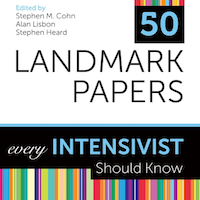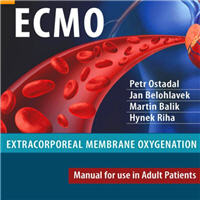Tag: sepsis
Prediction of AKI in ICU Patients Based on Interpretable Machine Learning
The machine learning model described in this study is capable of accurately predicting the onset of AKI in ICU patients up to 24 hours in advance. Validated within the MIMIC-IV and MIMIC-III databases, the model demonstrates... read more
Intubate Patients with Sepsis Before Midnight or When the Time Comes?
The ever-recurring decision for every clinician is to act or not to act and when to act. The balance of benefit or harm of an intervention and the optimal timing of treatment is not always clear. Intervening or not and... read more
Heparin-binding Protein Predicts Bacterial Infection in Severe Polytrauma Patients
In patients with severe polytrauma, heparin-binding protein may predict bacterial infection. Combining heparin-binding protein, PCT, and neutrophils may improve bacterial infection prediction. HBP provides a referenceable... read more
7-day Fluid Balance Associated with Poor Outcomes
The net fluid balance in patients with sepsis 7 days following ICU administration was significantly related to mortality during hospitalization. Specifically, a 7-day fluid balance > 5,240 mL was associated with poor... read more
Establishment and Validation of a Risk Prediction Model for Sepsis-Associated Liver Injury in ICU Patients
This novel nomogram effectively predicts SALI risk in sepsis patients by integrating readily available clinical parameters. While external validation is needed, the model shows promise as a practical tool for early risk stratification,... read more
Sepsis Patients with Disseminated Intravascular Coagulation
Sepsis is a life-threatening organ dysfunction caused by dysregulation of the body's response to infection, and is one of the leading causes of death in intensive care units. In sepsis, the systemic inflammatory reaction... read more
Sepsis: Methods and Protocols
This detailed volume presents a variety of animal models that are commonly used to study sepsis and some key procedures to measure specific disease outcomes. The chapters describe well-established surgical and nonsurgical... read more
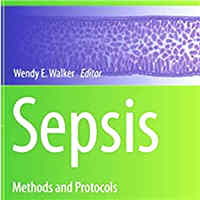
Increased Lactate Dehydrogenase to Albumin Ratio Associated with Short-term Mortality in Septic ICU Patients
Elevated lactate dehydrogenase to albumin ratio (LAR) was found to be significantly associated with an increased risk of all-cause mortality at 28 and 90 days in septic patients. LAR was suggested to be promising biomarker... read more
Procalcitonin Correlation with SEPSIS Severity in ICU Patients
High rates of morbidity and death are linked to sepsis, a potentially fatal illness. Procalcitonin (PCT), a biomarker of bacterial infection, is increasingly used in sepsis management to evaluate disease severity and guide... read more
The Role of Rotational Thromboelastometry in Early Detection of the Hemostatic Derangements in Neonates with Systemic Candida Infection
Rotational thromboelastometry (ROTEM) parameters revealed a hypocoagulable profile in neonates during the early stages of SCI, which is also associated with disease severity. The results of this study highlight the need for... read more
Association Between SHR and Mortality in Patients with Heart Failure Complicated by Sepsis
This study suggests that stress hyperglycemia ratio (SHR) may be a valuable predictor of prognosis in patients with heart failure combined with sepsis. Both high and low SHR values are associated with poorer outcomes.... read more
Plasma Proteome Temporal Changes Associated with Sepsis Mortality
Our proteomics approach revealed significant associations between changes in the plasma proteome within the first days of sepsis and mortality as well as disease severity. We identified and characterised the underlying... read more
Strong Ion Difference to Predict Mortality in Septic Shock: Mortality Prediction Model for Admission and 24-hour Mortality
Stewart's model examines the relationship between the movement of ions across biological membranes and the consequent changes in pH related to modifications in three dependent variables which are the strong ion difference... read more

Shock Indices as Prognostic Indicators: among Sepsis and Septic Shock Patients with and without Comorbidities Presenting to Emergency Department
Almost 30 million people are affected, and 3 million deaths happen every year because of sepsis. According to WHO's (World Health Organization) Global Report on Epidemiology and Burden of Sepsis report 2020, half of the... read more
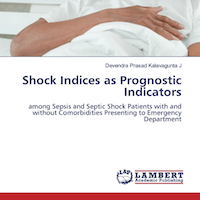
Biomarkers in Trauma, Injury and Critical Care (Biomarkers in Disease: Methods, Discoveries and Applications)
This handbook systematically presents biomarkers for traumatic injuries. The book covers topics such as traumatic brain injury, liver injury, burn severity, muscle heart damage, and acute inflammation in polytrauma and their... read more
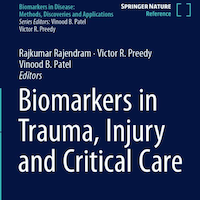
Heart Rate Control in Septic Shock: Echocardiographic Evaluation and Monitoring
Our study demonstrated a modest reduction in heart rate by approximately 10 beats per minute, accompanied by a slower decrease in noradrenaline requirements com-pared to the control group in the overall population. This... read more
Effect on Norepinephrine Administration Timing on Prognosis of Septic Shock Patients
Norepinephrine initiation ≤1 h is associated with lower 28-day mortality in patients with septic shock. Early norepinephrine administration is also associated with a shorter time to achieve MAP ≥65 mmHg, lower 24-h intravenous... read more
Sepsis: Clinical Diagnosis and Treatment
Sometimes our body's reaction to infection can result in damage to internal tissues and organs. Such a condition is referred to as sepsis. Some of the symptoms of sepsis are high fever, increased heart and breathing rate,... read more
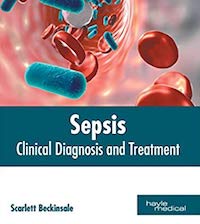
An Optimal Antibiotic Selection Framework for Sepsis Patients Using AI
In this work we present OptAB, the first completely data-driven online-updateable antibiotic selection model based on Artificial Intelligence (AI) for Sepsis patients accounting for side-effects. OptAB performs an iterative... read more
Personalized Therapies in ARDS
Acute respiratory distress syndrome (ARDS) can result from a variety of clinical conditions, causing lung injury either directly through local inflammation or indirectly because of systemic inflammatory mediators ARDS is... read more
Personalizing Beta-blockade in Septic Shock
Clinical trials provide only part of the necessary framework for clinical decision-making. In practice, a detailed understanding of each patient’s hemodynamic profile is essential. We believe that the echocardiography-guided... read more
Lymphocyte Count Trajectories Associated with Prognosis of Sepsis Patients
Three distinct lymphocyte trajectories were identified in sepsis patients using GBTM. Trajectory 3 was a strong predictor of 7-day and 28-day mortality, while Trajectory 1 was associated with early death. These findings... read more



